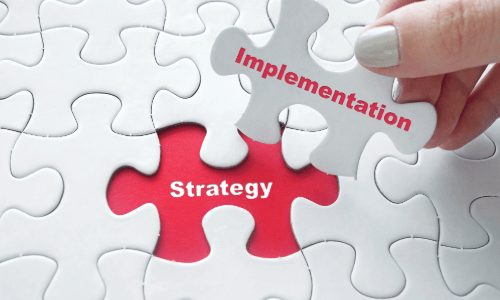Table of contents
Effective leadership in strategic planning is the deciding factor between merely setting objectives and truly achieving them. As a leader, how do you ensure that your strategic plan materializes into success? This article cuts through the noise to outline the defining traits and strategies of effective leadership that can steer teams towards their strategic goals. Expect an in-depth look at how visionary thinking, motivation, and fostering a culture of improvement drives organizations from planning to execution.
Key Takeaways
Effective leadership in strategic planning requires visionary thinking, motivating and inspiring the team, and fostering a culture of continuous improvement to guide the organization towards accomplishing its long-term goals.
Strategic leadership skills such as analytical and critical thinking, decision-making, problem-solving, effective communication, and collaboration are essential for dissecting complex issues, making informed decisions, and ensuring team unity.
Developing and implementing a strategic plan is an ongoing process that involves formulating strategy, allocating resources, monitoring progress, and adjusting the course, while also engaging the entire organization through inclusive planning, empowering employees, and encouraging feedback and continuous learning.
The Role of Leadership in Strategic Planning

Leadership in strategic planning is not just about charting a course; it’s about inspiring the crew to sail towards the horizon even amidst stormy seas. An effective leader not only sets the strategic vision but also ensures that every member of the team understands their role in achieving the plan. Leaders are the architects of the strategic planning process, creating the blueprint for the organization’s future.
But what does this leadership actually entail? It’s about visionary thinking, motivating and inspiring the team, and fostering a culture of continuous improvement. Let’s examine these aspects in detail.
Visionary Thinking
The ability to envision a clear and compelling future state is a cornerstone of strategic leadership. Leaders must be able to:
Articulate a strategic vision
Engage stakeholders at all levels
Construct a strategic direction derived from insights gathered from environmental scans and internal analysis
Facilitate everyone’s understanding of their role in the plan’s execution.
The ability to envision such a future does not come naturally. It requires strategic leaders to consider staff and stakeholder input to build a future vision. Visionary thinking, therefore, requires a balance of intuition, creativity, and data-driven analysis.
Motivation and Inspiration
Transforming a vision into reality requires more than just a plan; it needs the collective effort of the team. Leaders can ignite this collective effort by consistently communicating the overall vision and value statements, helping employees understand the importance of their tasks.
Motivating teams involves:
Setting challenging yet attainable goals
Acknowledging team members’ contributions
Applauding successes
Upholding morale
These are key to keeping the team inspired and focused on the strategic plan.
Fostering a Culture of Improvement
A culture of continuous improvement is essential for any organization seeking to stay ahead in today’s fast-paced business world. This culture is underpinned by ‘strategic resilience’, the ability of a firm to continuously anticipate and adjust to trends, as emphasized by the Harvard Business Review.
Leaders nurture this culture by demonstrating their dedication to initiatives and setting an example. They remain receptive to all types of suggestions, looking beyond mere profitability or return on investment. As a result, leaders cultivate a culture where employees are encouraged to suggest improvements, and the organization becomes agile, ready to adapt to market trends.
Essential Skills for Strategic Leaders

Strategic leadership is not just about setting the direction; it involves guiding the team along the path. For effective guidance, strategic leaders need to hone certain vital skills such as:
Analytical and critical thinking
Decision-making
Problem-solving
Effective communication
Collaboration
These skills enable leaders to dissect complex issues, make informed decisions, solve problems effectively, and communicate strategic goals convincingly. Let’s explore these skills in detail.
Analytical and Critical Thinking
Navigating the intricate web of organizational operations, leaders must possess the acumen to dissect issues and comprehend the interdependencies within the organization. This requires strong analytical skills, allowing leaders to make decisions based on evidence and analysis.
Critical thinking complements analytical skills. Leaders need to:
Gather, analyze, and synthesize data to inform decisions
Identify root causes
Consider alternative perspectives
Weigh possibilities
Conclude
This ability to question, make connections between ideas, and evaluate options is crucial for strategic thinking and problem-solving.
Decision-Making and Problem-Solving
Decision-making and problem-solving are the heart and soul of strategic leadership. Leaders employ critical thinking to tackle regular challenges and plot a course for goal achievement, showcasing the indispensable role of strategic thought in steering strategic decision making.
Strategic leaders, including business leaders and the strategic leader, make decisions by considering the speed of action and rigor of analysis, weighing both immediate and future implications. They address problems by focusing on underlying causes, promoting diverse perspectives to challenge prevailing assumptions, and cultivating a culture that encourages debate and fresh approaches to longstanding issues.
Communication and Collaboration
Communication and collaboration form the backbone of any organization, and it’s imperative for strategic leaders to excel in these areas. They are responsible for uniting the entire team around a common purpose and explaining organizational goals in a comprehensive manner.
Leaders navigate communication challenges such as overcommunication, misunderstandings, language barriers, and connecting with remote team members. They leverage various communication channels, including meetings, emails, collaboration platforms, and social media, ensuring that everyone within the organization is aligned and moving towards the set goals.
Developing and Implementing a Strategic Plan

Developing and implementing a strategic plan is like crafting a map for a journey. The map helps the organization identify where it wants to go (the vision), how it plans to get there (the strategy), and the milestones along the way (the organization’s goals and objectives).
But unlike a one-time journey, a strategic plan is a living document that needs to be continually updated and adjusted based on the organization’s progress, changes in the landscape, and new opportunities. These adjustments are essential for creating effective strategic plans.
Let’s examine the process of developing and implementing a strategic plan with the help of strategic planners.
Formulating Strategy
Formulating a business strategy is like choosing the best route to reach a destination. It involves strategic thinking, evaluating long-term prospects, and setting focused goals and objectives. This process isn’t executed in isolation, but in collaboration with internal stakeholders and senior leadership, paving the way for a shared vision and a competitive strategy.
Developing a detailed strategic plan includes defining precise metrics, setting realistic timelines, and instituting effective tracking of progress. This way, the organization can measure its progress towards achieving the set strategic objectives and goals.
Allocating Resources
Just as a journey requires resources like fuel and provisions, achieving strategic goals requires the allocation of resources — money, talent, and management focus. Strategic resource allocation is the process of managing and allocating these assets to support the organization’s strategic goals. In this context, strategic management plays a crucial role in ensuring the effective use of resources to achieve the desired outcomes.
Leaders allocate resources based on business priorities, maintaining adaptability to effectively address unforeseen requirements. As companies grow and goals evolve, the process of resource allocation should be ongoing and flexible to adjust to these changes.
Monitoring Progress and Adjusting Course
Monitoring progress and adjusting the course can be likened to consulting a map and modifying your route mid-journey. Setting specific, quantifiable targets for performance metrics each quarter is essential to track and assess progress in the strategic plan.
During progress reviews, it is important to have open discussions about progress on goals, acknowledging both successes and areas needing improvement. When deviations from the strategic plan are identified, or new opportunities arise, the strategy should be updated and adjusted accordingly.
Engaging the Entire Organization

In the journey of strategic planning, everyone in the organization is a crew member. Engaging the entire organization in strategic planning fosters collaboration, inclusivity, and empowerment.
Involvement of everyone, regardless of their career level or experience, ensures a broad support for strategic initiatives and fosters a culture where everyone contributes to the realization of the organization’s goals. Let’s examine the process of this engagement.
Inclusive Planning
Inclusive planning ensures that everyone’s voice is heard. Developing a culture of collaboration helps ensure that employees feel their ideas are heard and valued, which leads to increased engagement and motivation.
Inclusivity in strategic planning is achieved by:
Allowing all relevant individuals from various departments and levels in the organization to be involved and contribute their perspectives and expertise
Leveraging a wide range of insights
Making strategic planning a collective effort
This ensures that all voices are heard and considered in the planning process.
Empowering Employees
Empowering employees is like giving the crew the tools they need to navigate the journey. Inclusive strategic planning practices empower stakeholders from various parts of the business to create detailed plans that are integral to the larger strategy.
Empowered employees are more engaged, leading to improved performance for the firm. Acknowledging and rewarding employee suggestions and efforts can also boost further participation and engagement in the organization’s strategic direction.
Encouraging Feedback and Continuous Learning
A culture of feedback and continuous learning is like a compass that keeps the organization on course. It fosters agility, faster learning, and better customer service.
To foster an environment of continuous learning, leaders must:
Create opportunities for employees to share their ideas
Establish open lines of communication with upper management
Provide continuous feedback at all levels of seniority
These actions allow employees to grow and develop, enhancing their contribution to strategic planning.
Summary
In the journey of strategic planning, leadership is the force that turns the beacon of strategy into a clear path towards success. Leaders set the vision, foster a culture of improvement, and communicate the plan effectively. They possess essential skills such as analytical and critical thinking, decision-making, problem-solving, and effective communication and collaboration.
The strategic planning process is a journey that requires formulating a strategy, allocating resources, monitoring progress, and adjusting the course. It involves engaging the entire organization, fostering a culture of inclusivity, empowering employees, and encouraging feedback and continuous learning. By understanding and applying these principles, leaders can navigate their organizations towards a successful future.
Frequently Asked Questions
What role does leadership play in strategic planning?
Leadership plays a crucial role in advocating for plan execution, communicating the strategic plan clearly, setting goals, aligning stakeholders, making difficult decisions, and adapting to changes in the business environment. These are essential aspects of successful strategic planning that require strong leadership.
What does leadership mean in strategic management?
Leadership in strategic management entails making decisions to achieve the organization’s vision, ensuring proper functioning, and guiding the entire strategic management process through effective decision making (Answer 1).
Why is leadership important in planning?
Leadership is important in planning because it provides the link between planning and execution, facilitates consensus on goals, aligns stakeholders, and ensures effective use of resources. Effective leadership is essential for successful strategic planning and execution.
What are the 4 types of strategic leadership?
The 4 types of strategic leadership are transactional, transformational, visionary, and collaborative leadership. Each type plays a key role in effective strategic leadership.
What are the essential skills for strategic leaders?
The essential skills for strategic leaders include analytical and critical thinking, decision-making, problem-solving, and effective communication and collaboration skills. These skills are crucial for successful leadership in complex and dynamic environments.


